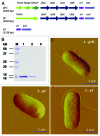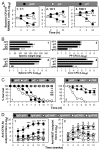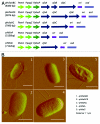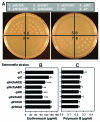Expression of Escherichia coli virulence usher protein attenuates wild-type Salmonella
- PMID: 22286706
- PMCID: PMC3337150
- DOI: 10.4161/viru.3.1.18447
Expression of Escherichia coli virulence usher protein attenuates wild-type Salmonella
Abstract
Generation of a live attenuated vaccine for bacterial pathogens often requires prior knowledge of the pathogen's virulence factors. We hypothesized an alternative approach of heterologous gene expression would make a wild-type (wt) pathogen more susceptible to host cell killing, thus, resulting in immunization. As proof of concept, the heterologous expression of enterotoxigenic E. coli (ETEC) colonization factor antigen I (CFA/I) was tested to attenuate Salmonella. The overexpression of CFA/I resulted in significant attenuation of wt Salmonella. In-depth studies revealed the attenuation depended on the co-expression of chaperone (CfaA) and usher (CfaC) proteins. Remarkably, the CfaAC-attenuated Salmonella conferred protection against wt Salmonella challenge. Mechanistic study indicated CfaAC made Salmonella outer membranes permeable, causing Salmonella to be vulnerable to host destruction. Thus, enhancing bacterial permeability via CfaAC represents an alternative method to attenuate pathogens despite the presence of unknown virulence factors.
Figures






Comment in
-
Coming of AGE: facile generation of attenuated vaccine strains through heterologous gene expression.Virulence. 2012 Jan-Feb;3(1):12-4. doi: 10.4161/viru.3.1.19087. Epub 2012 Jan 1. Virulence. 2012. PMID: 22286696 Free PMC article.
Similar articles
-
Coming of AGE: facile generation of attenuated vaccine strains through heterologous gene expression.Virulence. 2012 Jan-Feb;3(1):12-4. doi: 10.4161/viru.3.1.19087. Epub 2012 Jan 1. Virulence. 2012. PMID: 22286696 Free PMC article.
-
Attenuating gene expression (AGE) for vaccine development.Virulence. 2013 Jul 1;4(5):384-90. doi: 10.4161/viru.24886. Epub 2013 May 7. Virulence. 2013. PMID: 23652809 Free PMC article. Review.
-
Combined vaccine regimen based on parenteral priming with a DNA vaccine and administration of an oral booster consisting of a recombinant Salmonella enterica serovar Typhimurium vaccine strain for immunization against infection with human-derived enterotoxigenic Escherichia coli strains.Infect Immun. 2004 Nov;72(11):6480-91. doi: 10.1128/IAI.72.11.6480-6491.2004. Infect Immun. 2004. PMID: 15501779 Free PMC article.
-
Prime-boost vaccine regimen confers protective immunity to human-derived enterotoxigenic Escherichia coli.Vaccine. 2005 Mar 31;23(19):2430-8. doi: 10.1016/j.vaccine.2004.11.026. Vaccine. 2005. PMID: 15752829
-
The streptomycin mouse model for Salmonella diarrhea: functional analysis of the microbiota, the pathogen's virulence factors, and the host's mucosal immune response.Immunol Rev. 2012 Jan;245(1):56-83. doi: 10.1111/j.1600-065X.2011.01070.x. Immunol Rev. 2012. PMID: 22168414 Review.
Cited by
-
Regulatory T-cell vaccination independent of auto-antigen.Exp Mol Med. 2014 Mar 14;46(3):e82. doi: 10.1038/emm.2014.4. Exp Mol Med. 2014. PMID: 24626168 Free PMC article. Review.
-
Coming of AGE: facile generation of attenuated vaccine strains through heterologous gene expression.Virulence. 2012 Jan-Feb;3(1):12-4. doi: 10.4161/viru.3.1.19087. Epub 2012 Jan 1. Virulence. 2012. PMID: 22286696 Free PMC article.
-
Expression of periplasmic chaperones in Salmonella Typhimurium reduces its viability in vivo.Curr Microbiol. 2015 Mar;70(3):433-5. doi: 10.1007/s00284-014-0739-9. Epub 2014 Nov 29. Curr Microbiol. 2015. PMID: 25432864
-
Attenuating gene expression (AGE) for vaccine development.Virulence. 2013 Jul 1;4(5):384-90. doi: 10.4161/viru.24886. Epub 2013 May 7. Virulence. 2013. PMID: 23652809 Free PMC article. Review.
-
Role of overexpressed CFA/I fimbriae in bacterial swimming.Phys Biol. 2012 Jun;9(3):036005. doi: 10.1088/1478-3975/9/3/036005. Epub 2012 May 4. Phys Biol. 2012. PMID: 22562964 Free PMC article.
References
Publication types
MeSH terms
Substances
Grants and funding
LinkOut - more resources
Full Text Sources
Medical
Research Materials
